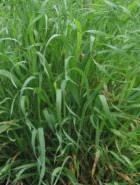 A rough looking cool weather perennial, quackgrass is a native of Europe, Asia and northwest Africa that was introduced into the United States for forage or as a contaminant in grain or hay and is widespread throughout most of the country except the Deep South. It prefers sunny sites and moist to slightly dry conditions in a wide variety of soils and can be found in gardens, lawns, croplands, pastures, abandoned fields, and waste areas. Quackgrass is aggressive and considered a noxious weed in many states although it is good for controlling erosion.
A rough looking cool weather perennial, quackgrass is a native of Europe, Asia and northwest Africa that was introduced into the United States for forage or as a contaminant in grain or hay and is widespread throughout most of the country except the Deep South. It prefers sunny sites and moist to slightly dry conditions in a wide variety of soils and can be found in gardens, lawns, croplands, pastures, abandoned fields, and waste areas. Quackgrass is aggressive and considered a noxious weed in many states although it is good for controlling erosion.
 Description: New plants emerge from early spring to mid summer and send up multiple somewhat erect stems 1 to 3 feet tall each bearing 3-6 leaves, that are dull to bluish-green and 8 inches long by 1/3 inch across.
Description: New plants emerge from early spring to mid summer and send up multiple somewhat erect stems 1 to 3 feet tall each bearing 3-6 leaves, that are dull to bluish-green and 8 inches long by 1/3 inch across.  The compact flower heads are borne at the tips of the stems in 2-8 inch spikes (raceme) each with two rows of spiklets bearing 3-7 florets. A single plant produces about 25 small tan colored seeds that can remain viable in the soil for 3 to 5 years. The root system consists of fibrous roots and rhizomes. The straw-colored rhizomes grow very long and have nodes spaced about an inch apart with each node producing fibrous roots and a whole new plant. The rhizomes are very tough and can grow through or around almost anything they encounter in the soil.
The compact flower heads are borne at the tips of the stems in 2-8 inch spikes (raceme) each with two rows of spiklets bearing 3-7 florets. A single plant produces about 25 small tan colored seeds that can remain viable in the soil for 3 to 5 years. The root system consists of fibrous roots and rhizomes. The straw-colored rhizomes grow very long and have nodes spaced about an inch apart with each node producing fibrous roots and a whole new plant. The rhizomes are very tough and can grow through or around almost anything they encounter in the soil.

 Control: The creeping rhizomes are the primary means of spread and effort should be made to eliminate them. Unfortunately small fragments left in the soil will sprout and form new plants so when removing the plants take a lot of soil with the plant and sift through it carefully before returning the soil to the garden bed. Clean all tools used in the digging carefully and plan to return to the dug site to dig out a batch of young plants that will inevitably sprout from undetected fragments. This procedure will have to be repeated for at least two seasons for any sort of quackgrass control. For large infestations mowing regularly will weaken the grass and tilling in the fall will bring roots to the surface that may be frozen in cold climates. Mowing will also spread of the plant by seeds. Planting a cover crop or a thick layer of mulch will slow down the growth of quackgrass but the grass will grow through the mulch. If chemical control seems necessary, herbicides like glyphosate are somewhat effective if applied while the quackgrass is vigorously growing. To encourage fast growth apply a high nitrogen fertilizer several days before using the herbicide and water well.
Control: The creeping rhizomes are the primary means of spread and effort should be made to eliminate them. Unfortunately small fragments left in the soil will sprout and form new plants so when removing the plants take a lot of soil with the plant and sift through it carefully before returning the soil to the garden bed. Clean all tools used in the digging carefully and plan to return to the dug site to dig out a batch of young plants that will inevitably sprout from undetected fragments. This procedure will have to be repeated for at least two seasons for any sort of quackgrass control. For large infestations mowing regularly will weaken the grass and tilling in the fall will bring roots to the surface that may be frozen in cold climates. Mowing will also spread of the plant by seeds. Planting a cover crop or a thick layer of mulch will slow down the growth of quackgrass but the grass will grow through the mulch. If chemical control seems necessary, herbicides like glyphosate are somewhat effective if applied while the quackgrass is vigorously growing. To encourage fast growth apply a high nitrogen fertilizer several days before using the herbicide and water well.